Final Examination - Financial Accounting and Reporting, MAC001A, 2021
VerifiedAdded on 2021/07/23
|16
|3770
|93
Homework Assignment
AI Summary
This document presents a comprehensive solution to the Final Examination for the Financial Accounting and Reporting course (MAC001A) from Trimester 1, 2021. The exam covers a wide range of topics including institutional arrangements for setting accounting standards, the conceptual framework, accounting methods, lease accounting, employee benefits, financial instruments, segment reporting, corporate social responsibility, cash flow statements, comprehensive income statements, and foreign currency translation. The document includes detailed solutions to various questions, including journal entries for lease accounting and employee benefits, along with theoretical explanations and practical applications. Additional exercises and theoretical components are also included to aid in understanding the concepts. The exam emphasizes key topics such as reporting entity, stakeholder theory, creative accounting, and the difference between presentation and functional currency.
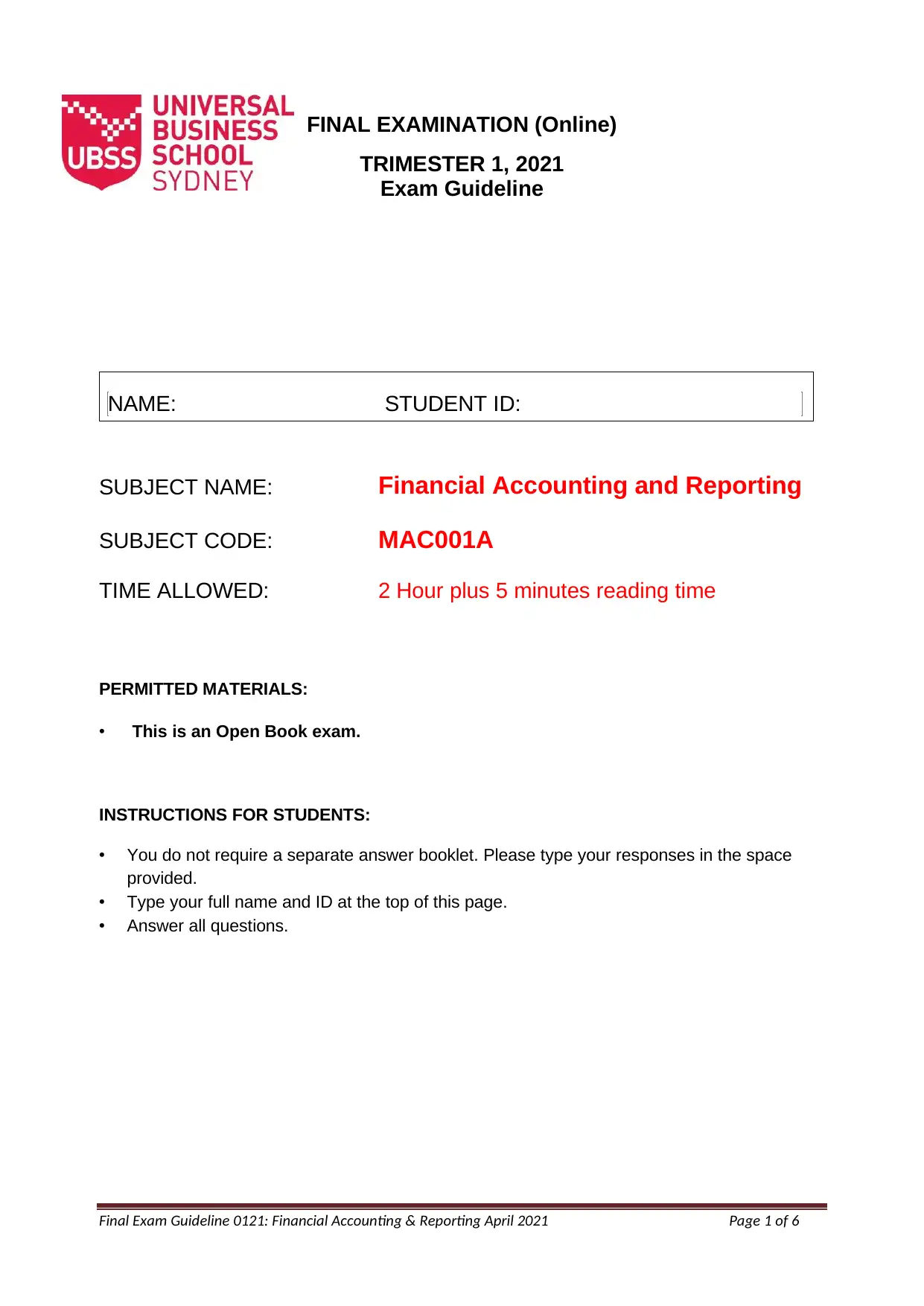
Final Exam Guideline 0121: Financial Accounting & Reporting April 2021 Page 1 of 6
FINAL EXAMINATION (Online)
TRIMESTER 1, 2021
Exam Guideline
NAME: STUDENT ID:
SUBJECT NAME: Financial Accounting and Reporting
SUBJECT CODE: MAC001A
TIME ALLOWED: 2 Hour plus 5 minutes reading time
PERMITTED MATERIALS:
• This is an Open Book exam.
INSTRUCTIONS FOR STUDENTS:
• You do not require a separate answer booklet. Please type your responses in the space
provided.
• Type your full name and ID at the top of this page.
• Answer all questions.
FINAL EXAMINATION (Online)
TRIMESTER 1, 2021
Exam Guideline
NAME: STUDENT ID:
SUBJECT NAME: Financial Accounting and Reporting
SUBJECT CODE: MAC001A
TIME ALLOWED: 2 Hour plus 5 minutes reading time
PERMITTED MATERIALS:
• This is an Open Book exam.
INSTRUCTIONS FOR STUDENTS:
• You do not require a separate answer booklet. Please type your responses in the space
provided.
• Type your full name and ID at the top of this page.
• Answer all questions.
Paraphrase This Document
Need a fresh take? Get an instant paraphrase of this document with our AI Paraphraser
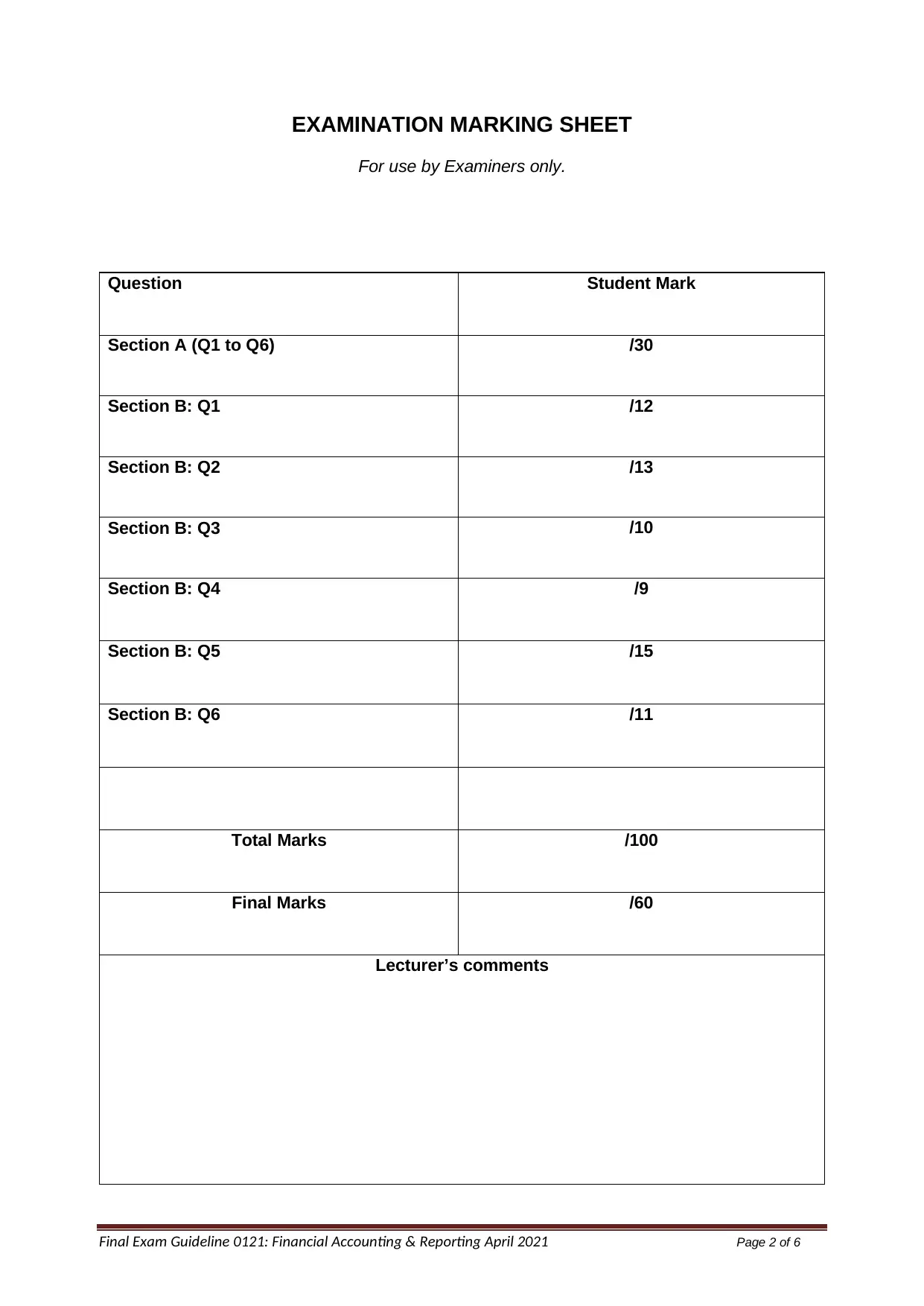
Final Exam Guideline 0121: Financial Accounting & Reporting April 2021 Page 2 of 6
EXAMINATION MARKING SHEET
For use by Examiners only.
Question Student Mark
Section A (Q1 to Q6) /30
Section B: Q1 /12
Section B: Q2 /13
Section B: Q3 /10
Section B: Q4 /9
Section B: Q5 /15
Section B: Q6 /11
Total Marks /100
Final Marks /60
Lecturer’s comments
EXAMINATION MARKING SHEET
For use by Examiners only.
Question Student Mark
Section A (Q1 to Q6) /30
Section B: Q1 /12
Section B: Q2 /13
Section B: Q3 /10
Section B: Q4 /9
Section B: Q5 /15
Section B: Q6 /11
Total Marks /100
Final Marks /60
Lecturer’s comments
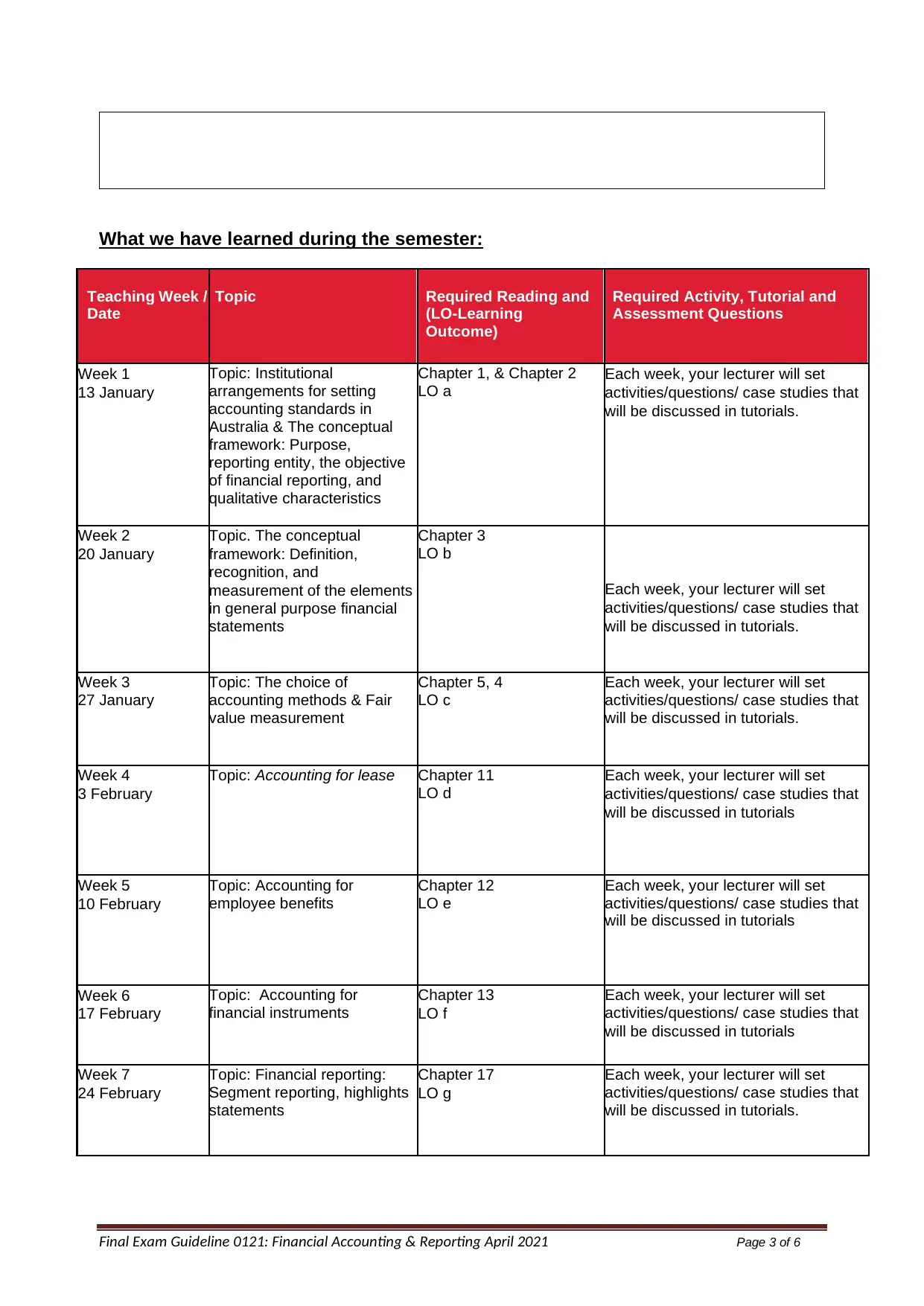
Final Exam Guideline 0121: Financial Accounting & Reporting April 2021 Page 3 of 6
What we have learned during the semester:
Teaching Week /
Date
Topic Required Reading and
(LO-Learning
Outcome)
Required Activity, Tutorial and
Assessment Questions
Week 1
13 January
Topic: Institutional
arrangements for setting
accounting standards in
Australia & The conceptual
framework: Purpose,
reporting entity, the objective
of financial reporting, and
qualitative characteristics
Chapter 1, & Chapter 2
LO a
Each week, your lecturer will set
activities/questions/ case studies that
will be discussed in tutorials.
Week 2
20 January
Topic. The conceptual
framework: Definition,
recognition, and
measurement of the elements
in general purpose financial
statements
Chapter 3
LO b
Each week, your lecturer will set
activities/questions/ case studies that
will be discussed in tutorials.
Week 3
27 January
Topic: The choice of
accounting methods & Fair
value measurement
Chapter 5, 4
LO c
Each week, your lecturer will set
activities/questions/ case studies that
will be discussed in tutorials.
Week 4
3 February
Topic: Accounting for lease Chapter 11
LO d
Each week, your lecturer will set
activities/questions/ case studies that
will be discussed in tutorials
Week 5
10 February
Topic: Accounting for
employee benefits
Chapter 12
LO e
Each week, your lecturer will set
activities/questions/ case studies that
will be discussed in tutorials
Week 6
17 February
Topic: Accounting for
financial instruments
Chapter 13
LO f
Each week, your lecturer will set
activities/questions/ case studies that
will be discussed in tutorials
Week 7
24 February
Topic: Financial reporting:
Segment reporting, highlights
statements
Chapter 17
LO g
Each week, your lecturer will set
activities/questions/ case studies that
will be discussed in tutorials.
What we have learned during the semester:
Teaching Week /
Date
Topic Required Reading and
(LO-Learning
Outcome)
Required Activity, Tutorial and
Assessment Questions
Week 1
13 January
Topic: Institutional
arrangements for setting
accounting standards in
Australia & The conceptual
framework: Purpose,
reporting entity, the objective
of financial reporting, and
qualitative characteristics
Chapter 1, & Chapter 2
LO a
Each week, your lecturer will set
activities/questions/ case studies that
will be discussed in tutorials.
Week 2
20 January
Topic. The conceptual
framework: Definition,
recognition, and
measurement of the elements
in general purpose financial
statements
Chapter 3
LO b
Each week, your lecturer will set
activities/questions/ case studies that
will be discussed in tutorials.
Week 3
27 January
Topic: The choice of
accounting methods & Fair
value measurement
Chapter 5, 4
LO c
Each week, your lecturer will set
activities/questions/ case studies that
will be discussed in tutorials.
Week 4
3 February
Topic: Accounting for lease Chapter 11
LO d
Each week, your lecturer will set
activities/questions/ case studies that
will be discussed in tutorials
Week 5
10 February
Topic: Accounting for
employee benefits
Chapter 12
LO e
Each week, your lecturer will set
activities/questions/ case studies that
will be discussed in tutorials
Week 6
17 February
Topic: Accounting for
financial instruments
Chapter 13
LO f
Each week, your lecturer will set
activities/questions/ case studies that
will be discussed in tutorials
Week 7
24 February
Topic: Financial reporting:
Segment reporting, highlights
statements
Chapter 17
LO g
Each week, your lecturer will set
activities/questions/ case studies that
will be discussed in tutorials.
⊘ This is a preview!⊘
Do you want full access?
Subscribe today to unlock all pages.

Trusted by 1+ million students worldwide
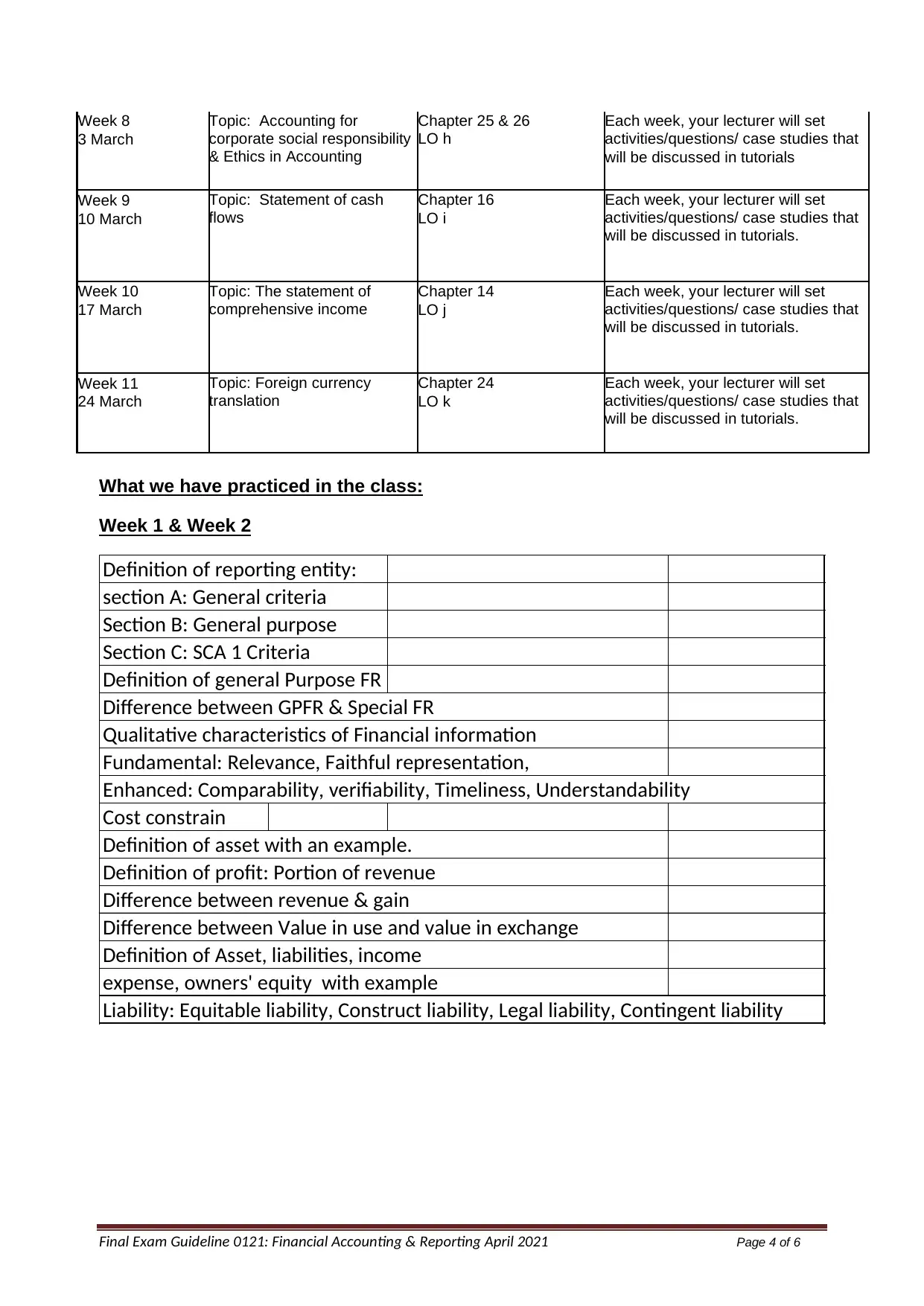
Final Exam Guideline 0121: Financial Accounting & Reporting April 2021 Page 4 of 6
Week 8
3 March
Topic: Accounting for
corporate social responsibility
& Ethics in Accounting
Chapter 25 & 26
LO h
Each week, your lecturer will set
activities/questions/ case studies that
will be discussed in tutorials
Week 9
10 March
Topic: Statement of cash
flows
Chapter 16
LO i
Each week, your lecturer will set
activities/questions/ case studies that
will be discussed in tutorials.
Week 10
17 March
Topic: The statement of
comprehensive income
Chapter 14
LO j
Each week, your lecturer will set
activities/questions/ case studies that
will be discussed in tutorials.
Week 11
24 March
Topic: Foreign currency
translation
Chapter 24
LO k
Each week, your lecturer will set
activities/questions/ case studies that
will be discussed in tutorials.
What we have practiced in the class:
Week 1 & Week 2
Definition of reporting entity:
section A: General criteria
Section B: General purpose
Section C: SCA 1 Criteria
Definition of general Purpose FR
Difference between GPFR & Special FR
Qualitative characteristics of Financial information
Fundamental: Relevance, Faithful representation,
Enhanced: Comparability, verifiability, Timeliness, Understandability
Cost constrain
Definition of asset with an example.
Definition of profit: Portion of revenue
Difference between revenue & gain
Difference between Value in use and value in exchange
Definition of Asset, liabilities, income
expense, owners' equity with example
Liability: Equitable liability, Construct liability, Legal liability, Contingent liability
Week 8
3 March
Topic: Accounting for
corporate social responsibility
& Ethics in Accounting
Chapter 25 & 26
LO h
Each week, your lecturer will set
activities/questions/ case studies that
will be discussed in tutorials
Week 9
10 March
Topic: Statement of cash
flows
Chapter 16
LO i
Each week, your lecturer will set
activities/questions/ case studies that
will be discussed in tutorials.
Week 10
17 March
Topic: The statement of
comprehensive income
Chapter 14
LO j
Each week, your lecturer will set
activities/questions/ case studies that
will be discussed in tutorials.
Week 11
24 March
Topic: Foreign currency
translation
Chapter 24
LO k
Each week, your lecturer will set
activities/questions/ case studies that
will be discussed in tutorials.
What we have practiced in the class:
Week 1 & Week 2
Definition of reporting entity:
section A: General criteria
Section B: General purpose
Section C: SCA 1 Criteria
Definition of general Purpose FR
Difference between GPFR & Special FR
Qualitative characteristics of Financial information
Fundamental: Relevance, Faithful representation,
Enhanced: Comparability, verifiability, Timeliness, Understandability
Cost constrain
Definition of asset with an example.
Definition of profit: Portion of revenue
Difference between revenue & gain
Difference between Value in use and value in exchange
Definition of Asset, liabilities, income
expense, owners' equity with example
Liability: Equitable liability, Construct liability, Legal liability, Contingent liability
Paraphrase This Document
Need a fresh take? Get an instant paraphrase of this document with our AI Paraphraser
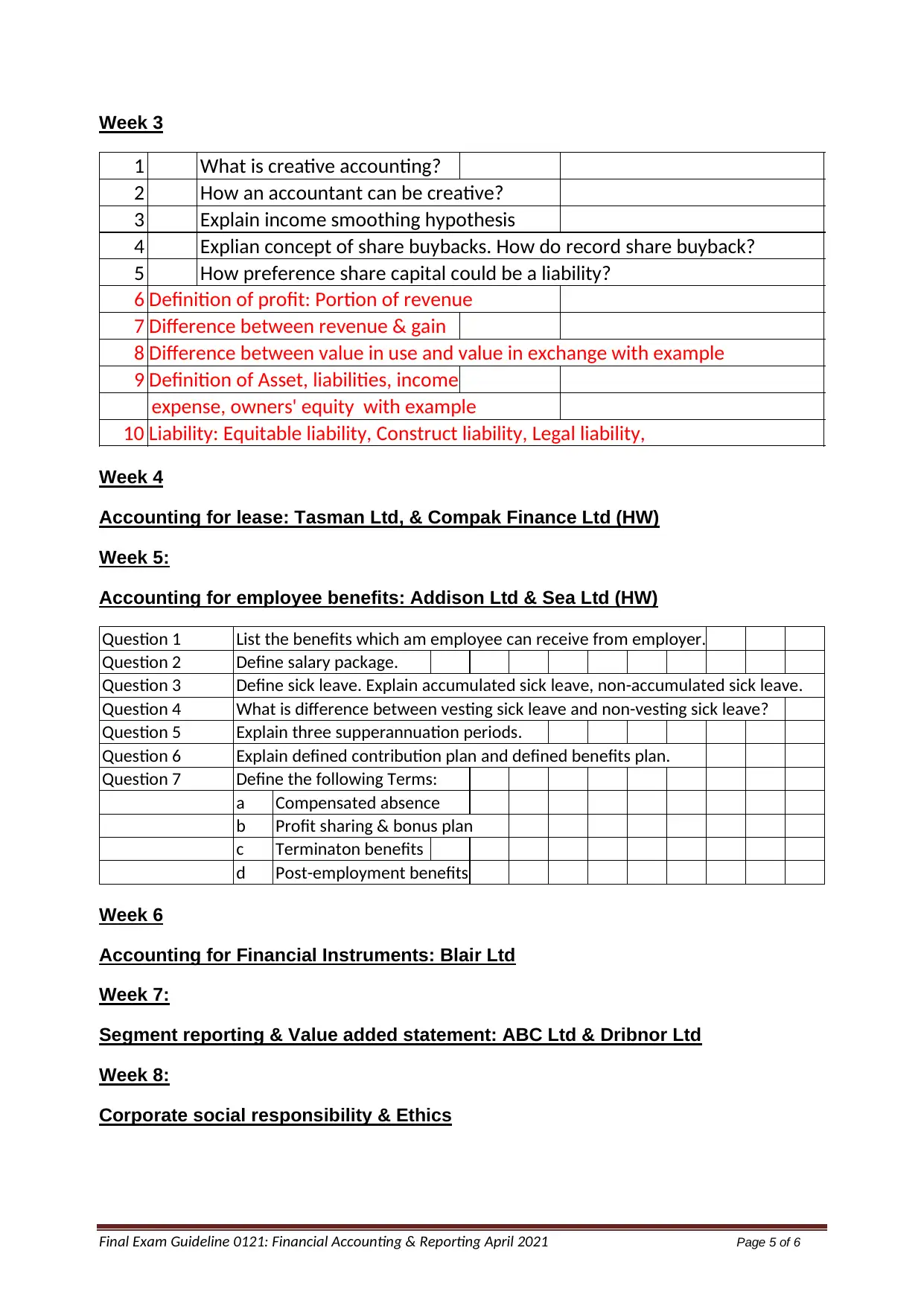
Final Exam Guideline 0121: Financial Accounting & Reporting April 2021 Page 5 of 6
Week 3
Week 4
Accounting for lease: Tasman Ltd, & Compak Finance Ltd (HW)
Week 5:
Accounting for employee benefits: Addison Ltd & Sea Ltd (HW)
Week 6
Accounting for Financial Instruments: Blair Ltd
Week 7:
Segment reporting & Value added statement: ABC Ltd & Dribnor Ltd
Week 8:
Corporate social responsibility & Ethics
1 What is creative accounting?
2 How an accountant can be creative?
3 Explain income smoothing hypothesis
4 Explian concept of share buybacks. How do record share buyback?
5 How preference share capital could be a liability?
6 Definition of profit: Portion of revenue
7 Difference between revenue & gain
8 Difference between value in use and value in exchange with example
9 Definition of Asset, liabilities, income
expense, owners' equity with example
10 Liability: Equitable liability, Construct liability, Legal liability,
Question 1 List the benefits which am employee can receive from employer.
Question 2 Define salary package.
Question 3 Define sick leave. Explain accumulated sick leave, non-accumulated sick leave.
Question 4 What is difference between vesting sick leave and non-vesting sick leave?
Question 5 Explain three supperannuation periods.
Question 6 Explain defined contribution plan and defined benefits plan.
Question 7 Define the following Terms:
a Compensated absence
b Profit sharing & bonus plan
c Terminaton benefits
d Post-employment benefits
Week 3
Week 4
Accounting for lease: Tasman Ltd, & Compak Finance Ltd (HW)
Week 5:
Accounting for employee benefits: Addison Ltd & Sea Ltd (HW)
Week 6
Accounting for Financial Instruments: Blair Ltd
Week 7:
Segment reporting & Value added statement: ABC Ltd & Dribnor Ltd
Week 8:
Corporate social responsibility & Ethics
1 What is creative accounting?
2 How an accountant can be creative?
3 Explain income smoothing hypothesis
4 Explian concept of share buybacks. How do record share buyback?
5 How preference share capital could be a liability?
6 Definition of profit: Portion of revenue
7 Difference between revenue & gain
8 Difference between value in use and value in exchange with example
9 Definition of Asset, liabilities, income
expense, owners' equity with example
10 Liability: Equitable liability, Construct liability, Legal liability,
Question 1 List the benefits which am employee can receive from employer.
Question 2 Define salary package.
Question 3 Define sick leave. Explain accumulated sick leave, non-accumulated sick leave.
Question 4 What is difference between vesting sick leave and non-vesting sick leave?
Question 5 Explain three supperannuation periods.
Question 6 Explain defined contribution plan and defined benefits plan.
Question 7 Define the following Terms:
a Compensated absence
b Profit sharing & bonus plan
c Terminaton benefits
d Post-employment benefits
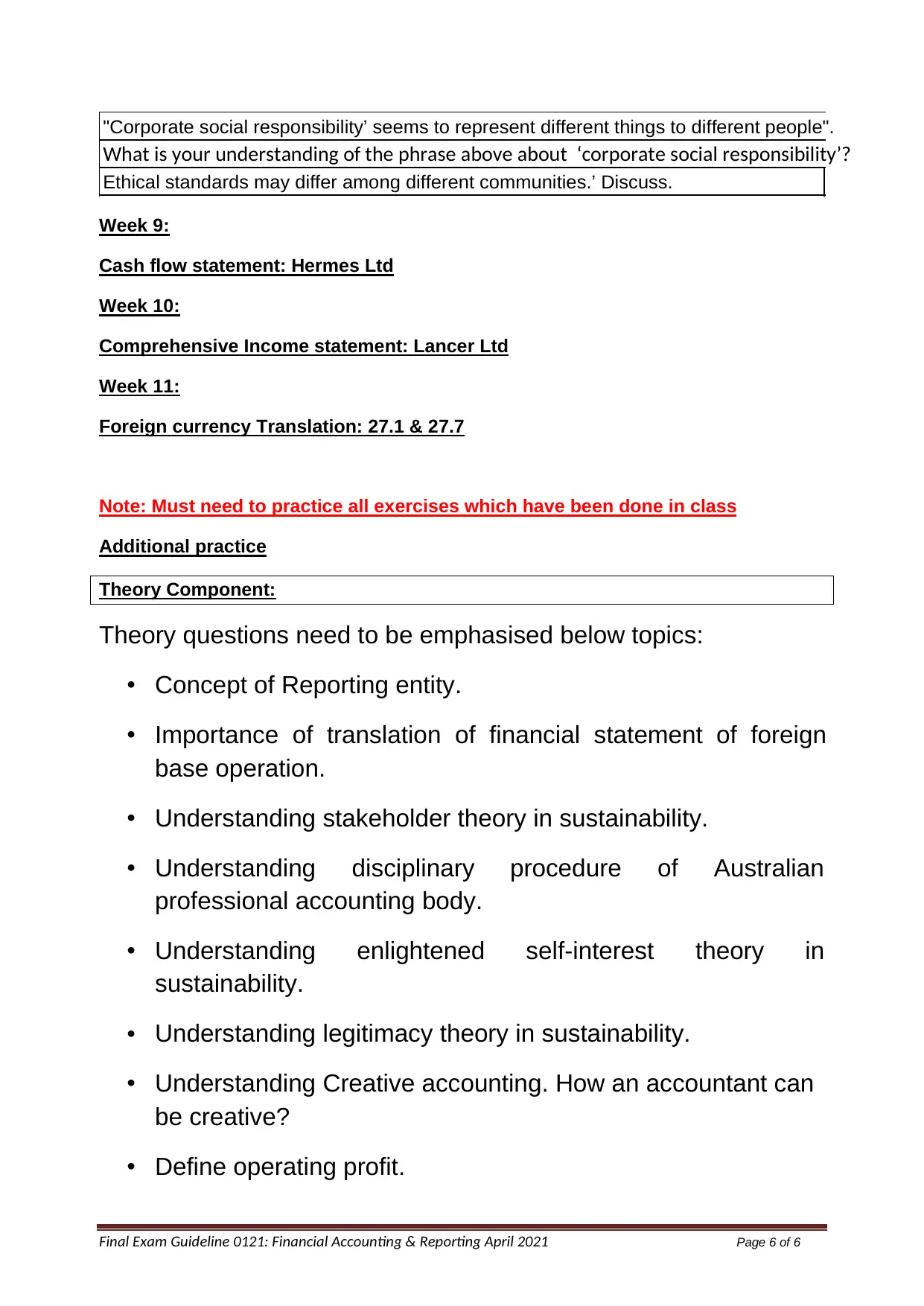
Final Exam Guideline 0121: Financial Accounting & Reporting April 2021 Page 6 of 6
Week 9:
Cash flow statement: Hermes Ltd
Week 10:
Comprehensive Income statement: Lancer Ltd
Week 11:
Foreign currency Translation: 27.1 & 27.7
Note: Must need to practice all exercises which have been done in class
Additional practice
Theory Component:
Theory questions need to be emphasised below topics:
• Concept of Reporting entity.
• Importance of translation of financial statement of foreign
base operation.
• Understanding stakeholder theory in sustainability.
• Understanding disciplinary procedure of Australian
professional accounting body.
• Understanding enlightened self-interest theory in
sustainability.
• Understanding legitimacy theory in sustainability.
• Understanding Creative accounting. How an accountant can
be creative?
• Define operating profit.
"Corporate social responsibility’ seems to represent different things to different people".
What is your understanding of the phrase above about ‘corporate social responsibility’?
Ethical standards may differ among different communities.’ Discuss.
Week 9:
Cash flow statement: Hermes Ltd
Week 10:
Comprehensive Income statement: Lancer Ltd
Week 11:
Foreign currency Translation: 27.1 & 27.7
Note: Must need to practice all exercises which have been done in class
Additional practice
Theory Component:
Theory questions need to be emphasised below topics:
• Concept of Reporting entity.
• Importance of translation of financial statement of foreign
base operation.
• Understanding stakeholder theory in sustainability.
• Understanding disciplinary procedure of Australian
professional accounting body.
• Understanding enlightened self-interest theory in
sustainability.
• Understanding legitimacy theory in sustainability.
• Understanding Creative accounting. How an accountant can
be creative?
• Define operating profit.
"Corporate social responsibility’ seems to represent different things to different people".
What is your understanding of the phrase above about ‘corporate social responsibility’?
Ethical standards may differ among different communities.’ Discuss.
⊘ This is a preview!⊘
Do you want full access?
Subscribe today to unlock all pages.

Trusted by 1+ million students worldwide
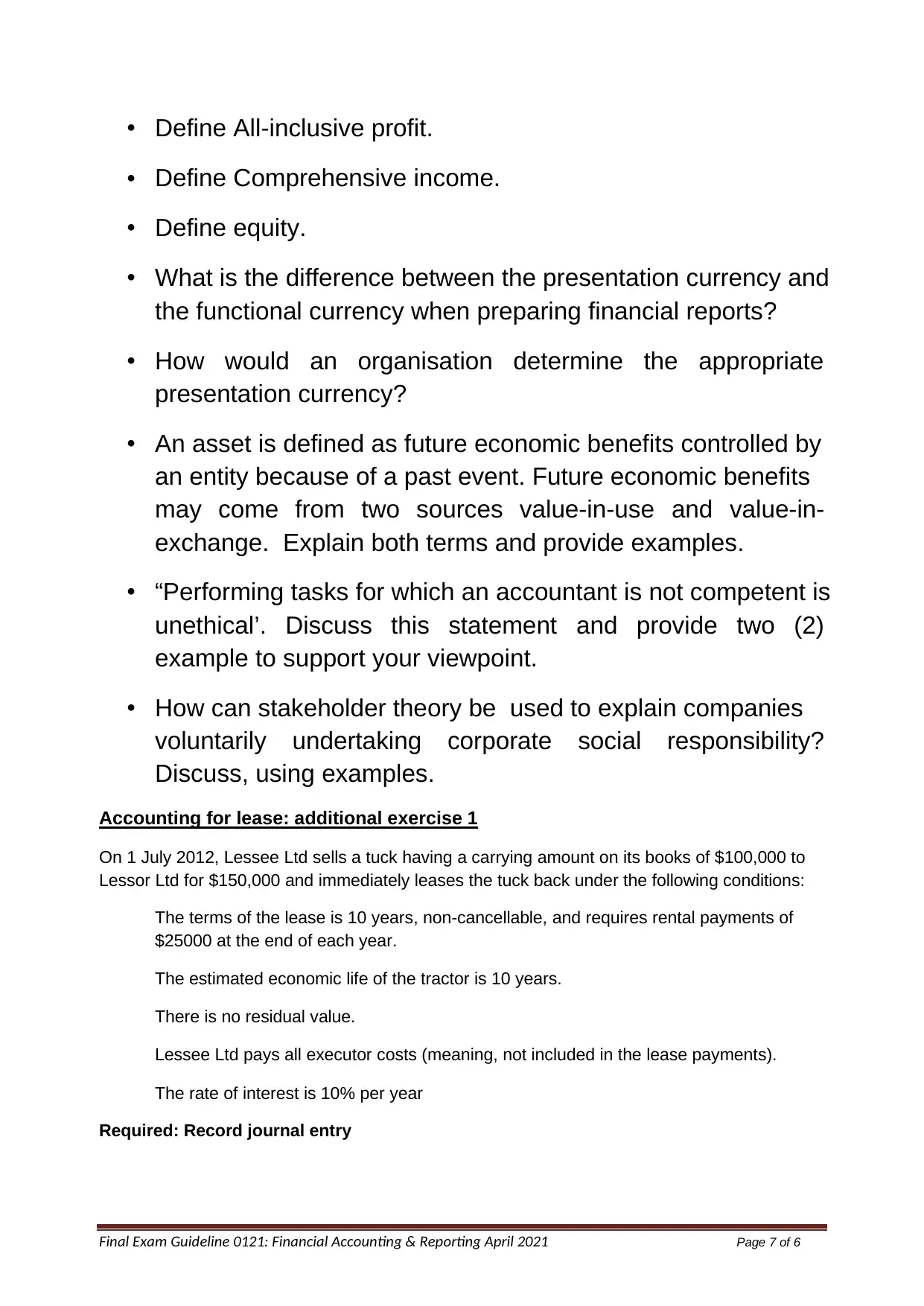
Final Exam Guideline 0121: Financial Accounting & Reporting April 2021 Page 7 of 6
• Define All-inclusive profit.
• Define Comprehensive income.
• Define equity.
• What is the difference between the presentation currency and
the functional currency when preparing financial reports?
• How would an organisation determine the appropriate
presentation currency?
• An asset is defined as future economic benefits controlled by
an entity because of a past event. Future economic benefits
may come from two sources value-in-use and value-in-
exchange. Explain both terms and provide examples.
• “Performing tasks for which an accountant is not competent is
unethical’. Discuss this statement and provide two (2)
example to support your viewpoint.
• How can stakeholder theory be used to explain companies
voluntarily undertaking corporate social responsibility?
Discuss, using examples.
Accounting for lease: additional exercise 1
On 1 July 2012, Lessee Ltd sells a tuck having a carrying amount on its books of $100,000 to
Lessor Ltd for $150,000 and immediately leases the tuck back under the following conditions:
The terms of the lease is 10 years, non-cancellable, and requires rental payments of
$25000 at the end of each year.
The estimated economic life of the tractor is 10 years.
There is no residual value.
Lessee Ltd pays all executor costs (meaning, not included in the lease payments).
The rate of interest is 10% per year
Required: Record journal entry
• Define All-inclusive profit.
• Define Comprehensive income.
• Define equity.
• What is the difference between the presentation currency and
the functional currency when preparing financial reports?
• How would an organisation determine the appropriate
presentation currency?
• An asset is defined as future economic benefits controlled by
an entity because of a past event. Future economic benefits
may come from two sources value-in-use and value-in-
exchange. Explain both terms and provide examples.
• “Performing tasks for which an accountant is not competent is
unethical’. Discuss this statement and provide two (2)
example to support your viewpoint.
• How can stakeholder theory be used to explain companies
voluntarily undertaking corporate social responsibility?
Discuss, using examples.
Accounting for lease: additional exercise 1
On 1 July 2012, Lessee Ltd sells a tuck having a carrying amount on its books of $100,000 to
Lessor Ltd for $150,000 and immediately leases the tuck back under the following conditions:
The terms of the lease is 10 years, non-cancellable, and requires rental payments of
$25000 at the end of each year.
The estimated economic life of the tractor is 10 years.
There is no residual value.
Lessee Ltd pays all executor costs (meaning, not included in the lease payments).
The rate of interest is 10% per year
Required: Record journal entry
Paraphrase This Document
Need a fresh take? Get an instant paraphrase of this document with our AI Paraphraser
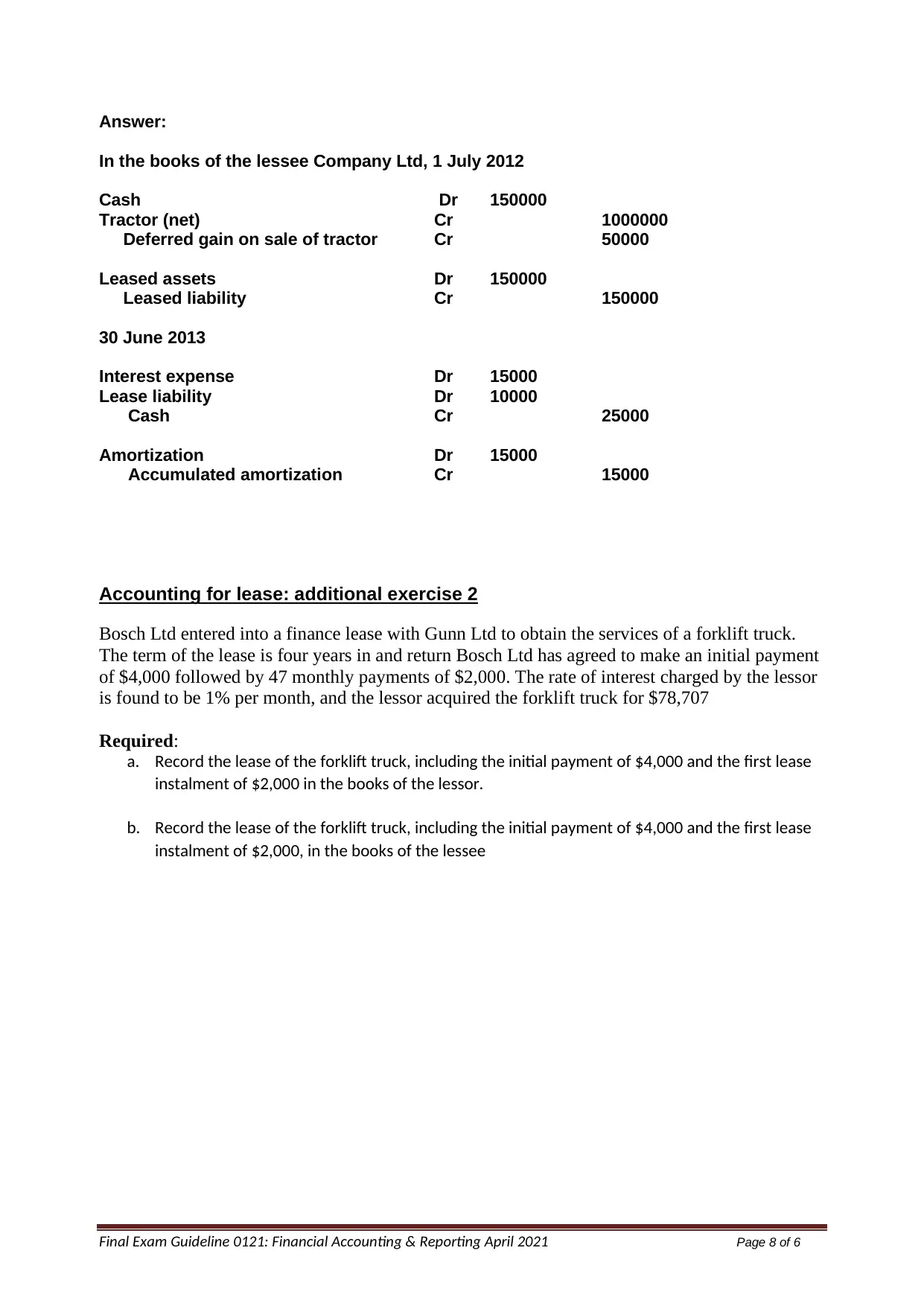
Final Exam Guideline 0121: Financial Accounting & Reporting April 2021 Page 8 of 6
Answer:
In the books of the lessee Company Ltd, 1 July 2012
Cash Dr 150000
Tractor (net) Cr 1000000
Deferred gain on sale of tractor Cr 50000
Leased assets Dr 150000
Leased liability Cr 150000
30 June 2013
Interest expense Dr 15000
Lease liability Dr 10000
Cash Cr 25000
Amortization Dr 15000
Accumulated amortization Cr 15000
Accounting for lease: additional exercise 2
Bosch Ltd entered into a finance lease with Gunn Ltd to obtain the services of a forklift truck.
The term of the lease is four years in and return Bosch Ltd has agreed to make an initial payment
of $4,000 followed by 47 monthly payments of $2,000. The rate of interest charged by the lessor
is found to be 1% per month, and the lessor acquired the forklift truck for $78,707
Required:
a. Record the lease of the forklift truck, including the initial payment of $4,000 and the first lease
instalment of $2,000 in the books of the lessor.
b. Record the lease of the forklift truck, including the initial payment of $4,000 and the first lease
instalment of $2,000, in the books of the lessee
Answer:
In the books of the lessee Company Ltd, 1 July 2012
Cash Dr 150000
Tractor (net) Cr 1000000
Deferred gain on sale of tractor Cr 50000
Leased assets Dr 150000
Leased liability Cr 150000
30 June 2013
Interest expense Dr 15000
Lease liability Dr 10000
Cash Cr 25000
Amortization Dr 15000
Accumulated amortization Cr 15000
Accounting for lease: additional exercise 2
Bosch Ltd entered into a finance lease with Gunn Ltd to obtain the services of a forklift truck.
The term of the lease is four years in and return Bosch Ltd has agreed to make an initial payment
of $4,000 followed by 47 monthly payments of $2,000. The rate of interest charged by the lessor
is found to be 1% per month, and the lessor acquired the forklift truck for $78,707
Required:
a. Record the lease of the forklift truck, including the initial payment of $4,000 and the first lease
instalment of $2,000 in the books of the lessor.
b. Record the lease of the forklift truck, including the initial payment of $4,000 and the first lease
instalment of $2,000, in the books of the lessee
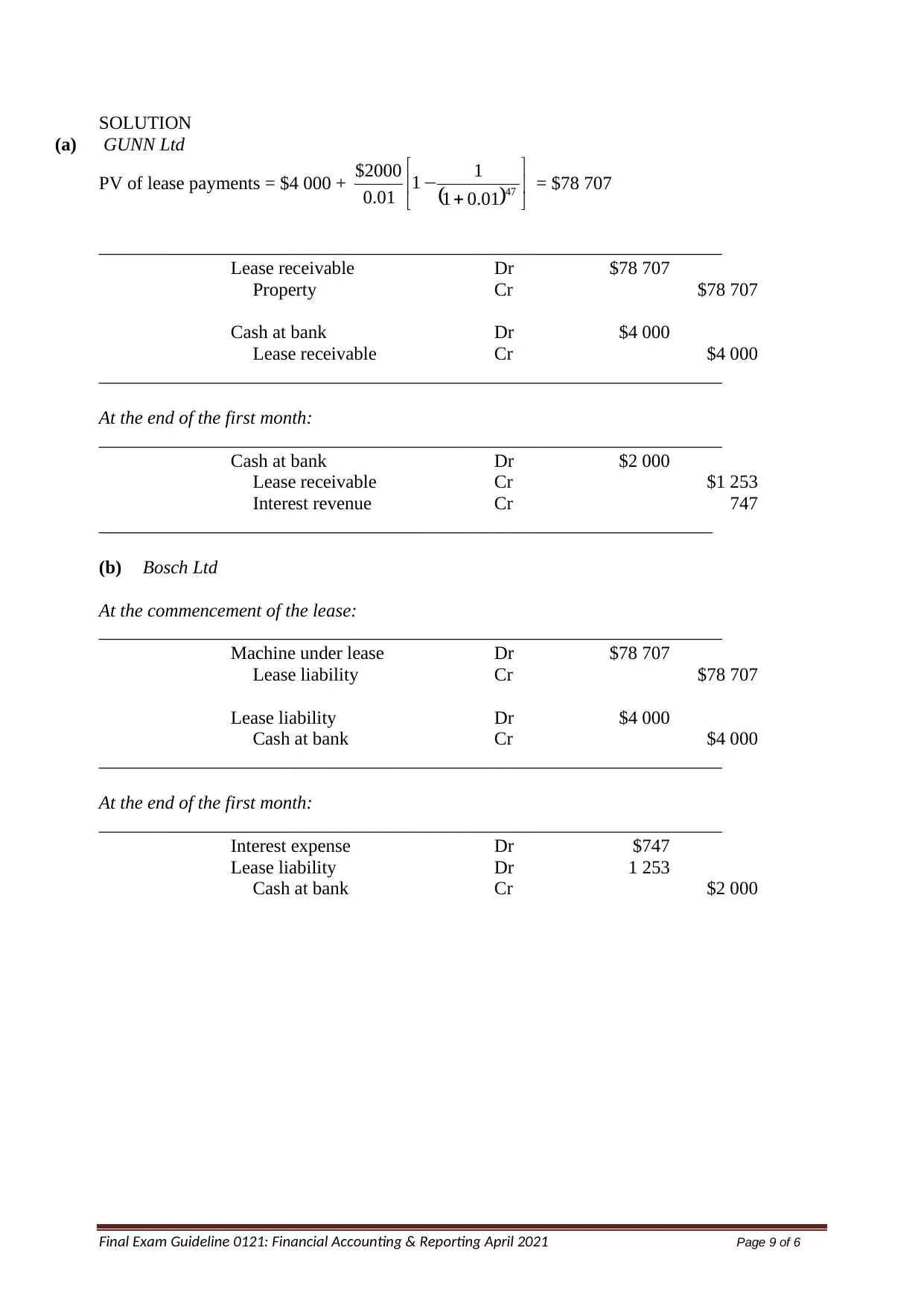
Final Exam Guideline 0121: Financial Accounting & Reporting April 2021 Page 9 of 6
SOLUTION
(a) GUNN Ltd
PV of lease payments = $4 000 + ( )
+
− 47
01.01
1
1
01.0
2000$ = $78 707
___________________________________________________________________
Lease receivable Dr $78 707
Property Cr $78 707
Cash at bank Dr $4 000
Lease receivable Cr $4 000
___________________________________________________________________
At the end of the first month:
___________________________________________________________________
Cash at bank Dr $2 000
Lease receivable Cr $1 253
Interest revenue Cr 747
__________________________________________________________________
(b) Bosch Ltd
At the commencement of the lease:
___________________________________________________________________
Machine under lease Dr $78 707
Lease liability Cr $78 707
Lease liability Dr $4 000
Cash at bank Cr $4 000
___________________________________________________________________
At the end of the first month:
___________________________________________________________________
Interest expense Dr $747
Lease liability Dr 1 253
Cash at bank Cr $2 000
SOLUTION
(a) GUNN Ltd
PV of lease payments = $4 000 + ( )
+
− 47
01.01
1
1
01.0
2000$ = $78 707
___________________________________________________________________
Lease receivable Dr $78 707
Property Cr $78 707
Cash at bank Dr $4 000
Lease receivable Cr $4 000
___________________________________________________________________
At the end of the first month:
___________________________________________________________________
Cash at bank Dr $2 000
Lease receivable Cr $1 253
Interest revenue Cr 747
__________________________________________________________________
(b) Bosch Ltd
At the commencement of the lease:
___________________________________________________________________
Machine under lease Dr $78 707
Lease liability Cr $78 707
Lease liability Dr $4 000
Cash at bank Cr $4 000
___________________________________________________________________
At the end of the first month:
___________________________________________________________________
Interest expense Dr $747
Lease liability Dr 1 253
Cash at bank Cr $2 000
⊘ This is a preview!⊘
Do you want full access?
Subscribe today to unlock all pages.

Trusted by 1+ million students worldwide
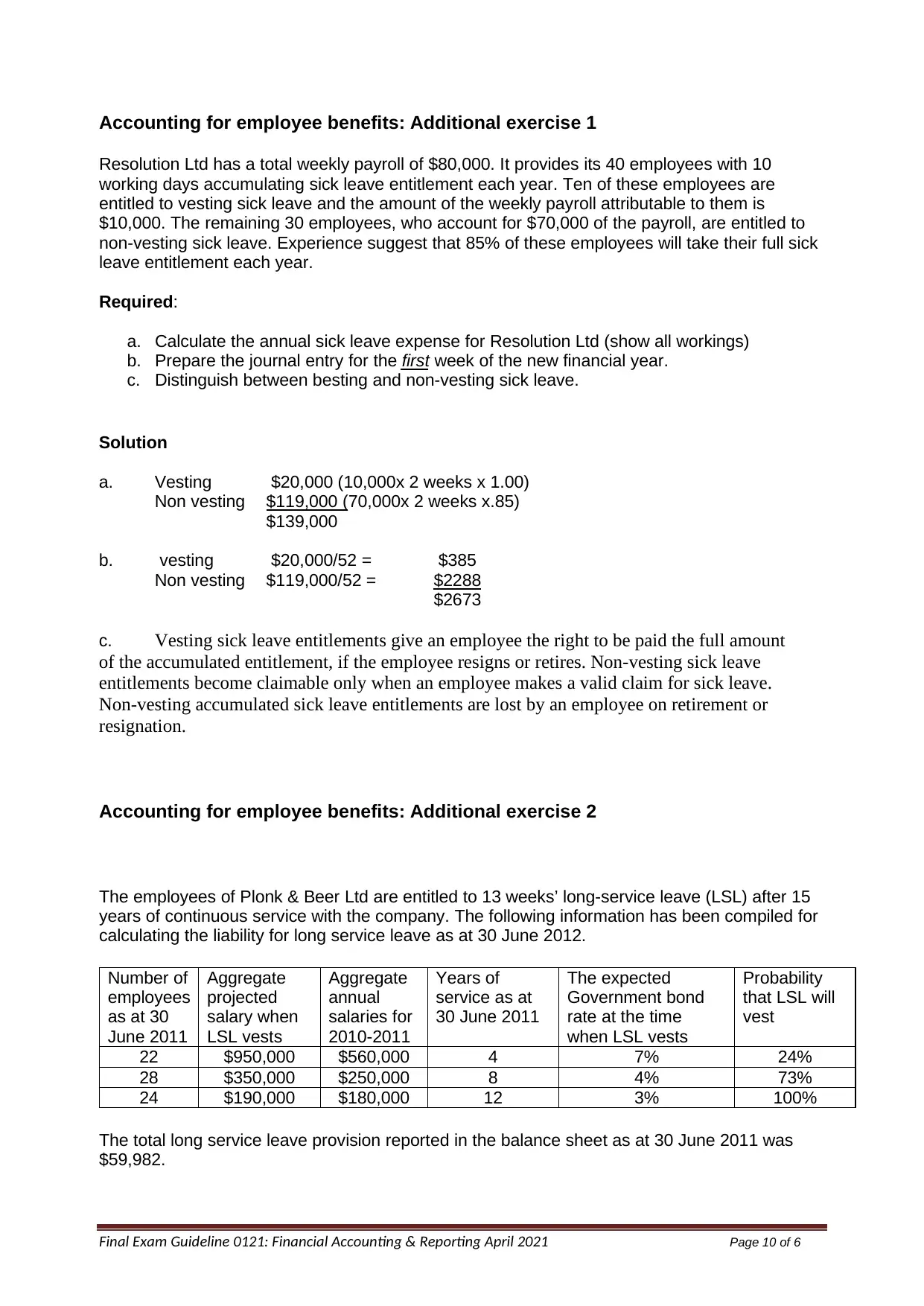
Final Exam Guideline 0121: Financial Accounting & Reporting April 2021 Page 10 of 6
Accounting for employee benefits: Additional exercise 1
Resolution Ltd has a total weekly payroll of $80,000. It provides its 40 employees with 10
working days accumulating sick leave entitlement each year. Ten of these employees are
entitled to vesting sick leave and the amount of the weekly payroll attributable to them is
$10,000. The remaining 30 employees, who account for $70,000 of the payroll, are entitled to
non-vesting sick leave. Experience suggest that 85% of these employees will take their full sick
leave entitlement each year.
Required:
a. Calculate the annual sick leave expense for Resolution Ltd (show all workings)
b. Prepare the journal entry for the first week of the new financial year.
c. Distinguish between besting and non-vesting sick leave.
Accounting for employee benefits: Additional exercise 2
The employees of Plonk & Beer Ltd are entitled to 13 weeks’ long-service leave (LSL) after 15
years of continuous service with the company. The following information has been compiled for
calculating the liability for long service leave as at 30 June 2012.
Number of
employees
as at 30
June 2011
Aggregate
projected
salary when
LSL vests
Aggregate
annual
salaries for
2010-2011
Years of
service as at
30 June 2011
The expected
Government bond
rate at the time
when LSL vests
Probability
that LSL will
vest
22 $950,000 $560,000 4 7% 24%
28 $350,000 $250,000 8 4% 73%
24 $190,000 $180,000 12 3% 100%
The total long service leave provision reported in the balance sheet as at 30 June 2011 was
$59,982.
Solution
a. Vesting $20,000 (10,000x 2 weeks x 1.00)
Non vesting $119,000 (70,000x 2 weeks x.85)
$139,000
b. vesting $20,000/52 = $385
Non vesting $119,000/52 = $2288
$2673
c. Vesting sick leave entitlements give an employee the right to be paid the full amount
of the accumulated entitlement, if the employee resigns or retires. Non-vesting sick leave
entitlements become claimable only when an employee makes a valid claim for sick leave.
Non-vesting accumulated sick leave entitlements are lost by an employee on retirement or
resignation.
Accounting for employee benefits: Additional exercise 1
Resolution Ltd has a total weekly payroll of $80,000. It provides its 40 employees with 10
working days accumulating sick leave entitlement each year. Ten of these employees are
entitled to vesting sick leave and the amount of the weekly payroll attributable to them is
$10,000. The remaining 30 employees, who account for $70,000 of the payroll, are entitled to
non-vesting sick leave. Experience suggest that 85% of these employees will take their full sick
leave entitlement each year.
Required:
a. Calculate the annual sick leave expense for Resolution Ltd (show all workings)
b. Prepare the journal entry for the first week of the new financial year.
c. Distinguish between besting and non-vesting sick leave.
Accounting for employee benefits: Additional exercise 2
The employees of Plonk & Beer Ltd are entitled to 13 weeks’ long-service leave (LSL) after 15
years of continuous service with the company. The following information has been compiled for
calculating the liability for long service leave as at 30 June 2012.
Number of
employees
as at 30
June 2011
Aggregate
projected
salary when
LSL vests
Aggregate
annual
salaries for
2010-2011
Years of
service as at
30 June 2011
The expected
Government bond
rate at the time
when LSL vests
Probability
that LSL will
vest
22 $950,000 $560,000 4 7% 24%
28 $350,000 $250,000 8 4% 73%
24 $190,000 $180,000 12 3% 100%
The total long service leave provision reported in the balance sheet as at 30 June 2011 was
$59,982.
Solution
a. Vesting $20,000 (10,000x 2 weeks x 1.00)
Non vesting $119,000 (70,000x 2 weeks x.85)
$139,000
b. vesting $20,000/52 = $385
Non vesting $119,000/52 = $2288
$2673
c. Vesting sick leave entitlements give an employee the right to be paid the full amount
of the accumulated entitlement, if the employee resigns or retires. Non-vesting sick leave
entitlements become claimable only when an employee makes a valid claim for sick leave.
Non-vesting accumulated sick leave entitlements are lost by an employee on retirement or
resignation.
Paraphrase This Document
Need a fresh take? Get an instant paraphrase of this document with our AI Paraphraser
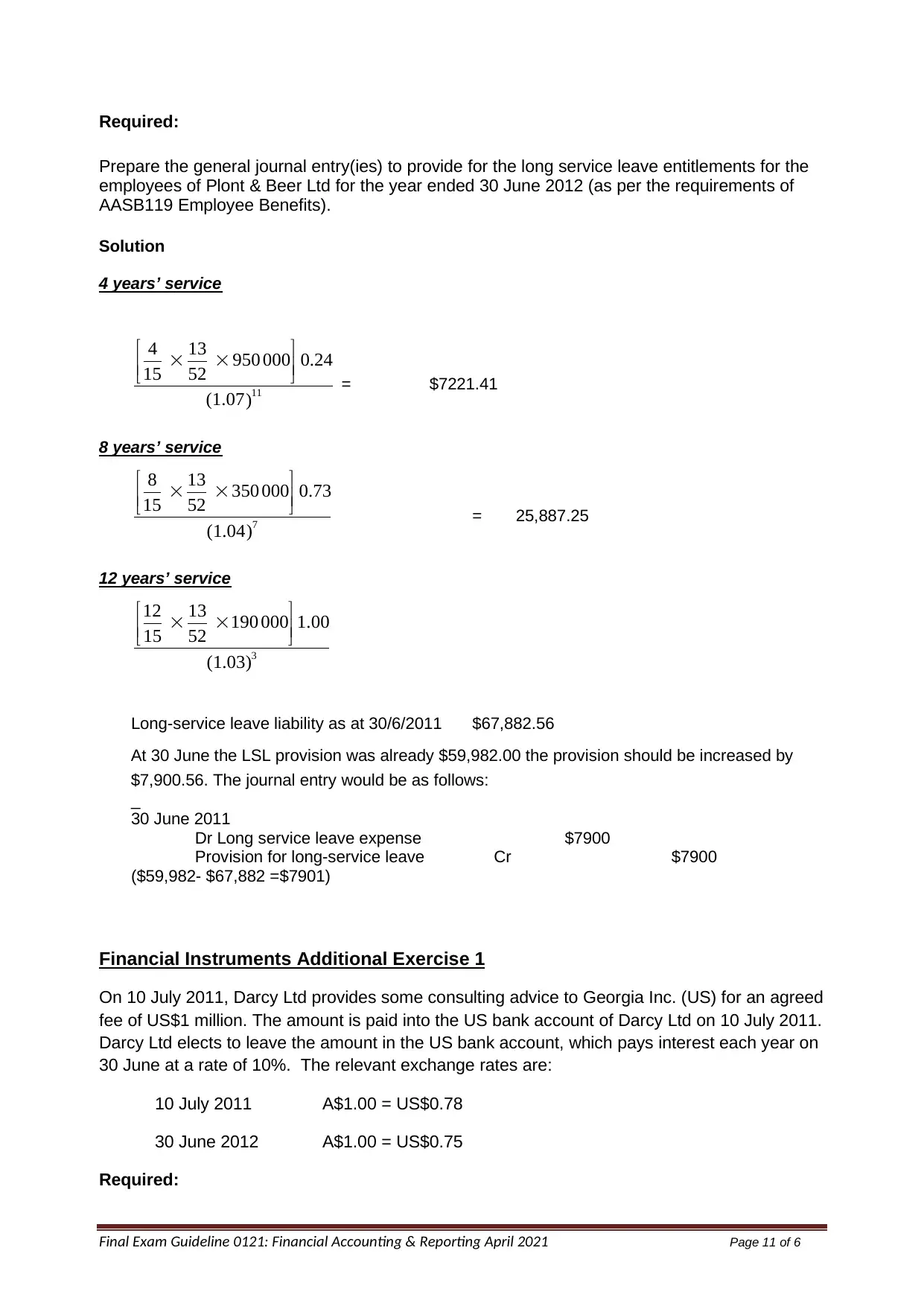
Final Exam Guideline 0121: Financial Accounting & Reporting April 2021 Page 11 of 6
Required:
Prepare the general journal entry(ies) to provide for the long service leave entitlements for the
employees of Plont & Beer Ltd for the year ended 30 June 2012 (as per the requirements of
AASB119 Employee Benefits).
Financial Instruments Additional Exercise 1
On 10 July 2011, Darcy Ltd provides some consulting advice to Georgia Inc. (US) for an agreed
fee of US$1 million. The amount is paid into the US bank account of Darcy Ltd on 10 July 2011.
Darcy Ltd elects to leave the amount in the US bank account, which pays interest each year on
30 June at a rate of 10%. The relevant exchange rates are:
10 July 2011 A$1.00 = US$0.78
30 June 2012 A$1.00 = US$0.75
Required:
Solution
4 years’ service
)(1.07
0.24000950
52
13
15
4
11
= $7221.41
8 years’ service
)(1.04
0.73000350
52
13
15
8
7
= 25,887.25
12 years’ service
)(1.03
1.00000190
52
13
15
12
3
Long-service leave liability as at 30/6/2011 $67,882.56
At 30 June the LSL provision was already $59,982.00 the provision should be increased by
$7,900.56. The journal entry would be as follows:
_
30 June 2011
Dr Long service leave expense $7900
Provision for long-service leave Cr $7900
($59,982- $67,882 =$7901)
Required:
Prepare the general journal entry(ies) to provide for the long service leave entitlements for the
employees of Plont & Beer Ltd for the year ended 30 June 2012 (as per the requirements of
AASB119 Employee Benefits).
Financial Instruments Additional Exercise 1
On 10 July 2011, Darcy Ltd provides some consulting advice to Georgia Inc. (US) for an agreed
fee of US$1 million. The amount is paid into the US bank account of Darcy Ltd on 10 July 2011.
Darcy Ltd elects to leave the amount in the US bank account, which pays interest each year on
30 June at a rate of 10%. The relevant exchange rates are:
10 July 2011 A$1.00 = US$0.78
30 June 2012 A$1.00 = US$0.75
Required:
Solution
4 years’ service
)(1.07
0.24000950
52
13
15
4
11
= $7221.41
8 years’ service
)(1.04
0.73000350
52
13
15
8
7
= 25,887.25
12 years’ service
)(1.03
1.00000190
52
13
15
12
3
Long-service leave liability as at 30/6/2011 $67,882.56
At 30 June the LSL provision was already $59,982.00 the provision should be increased by
$7,900.56. The journal entry would be as follows:
_
30 June 2011
Dr Long service leave expense $7900
Provision for long-service leave Cr $7900
($59,982- $67,882 =$7901)
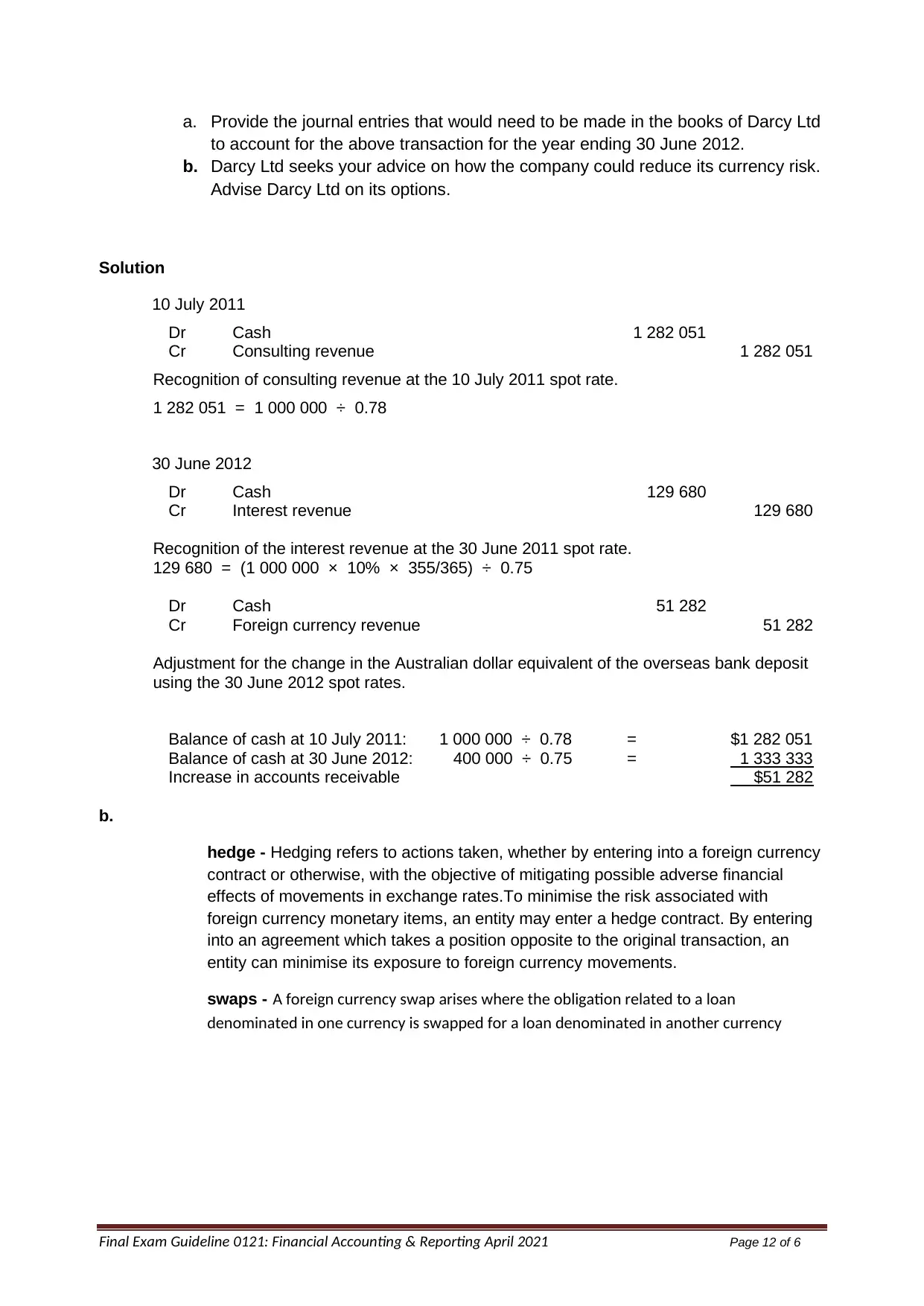
Final Exam Guideline 0121: Financial Accounting & Reporting April 2021 Page 12 of 6
a. Provide the journal entries that would need to be made in the books of Darcy Ltd
to account for the above transaction for the year ending 30 June 2012.
b. Darcy Ltd seeks your advice on how the company could reduce its currency risk.
Advise Darcy Ltd on its options.
Solution
10 July 2011
Dr Cash 1 282 051
Cr Consulting revenue 1 282 051
Recognition of consulting revenue at the 10 July 2011 spot rate.
1 282 051 = 1 000 000 ÷ 0.78
30 June 2012
Dr Cash 129 680
Cr Interest revenue 129 680
Recognition of the interest revenue at the 30 June 2011 spot rate.
129 680 = (1 000 000 × 10% × 355/365) ÷ 0.75
Dr Cash 51 282
Cr Foreign currency revenue 51 282
Adjustment for the change in the Australian dollar equivalent of the overseas bank deposit
using the 30 June 2012 spot rates.
Balance of cash at 10 July 2011: 1 000 000 ÷ 0.78 = $1 282 051
Balance of cash at 30 June 2012: 400 000 ÷ 0.75 = 1 333 333
Increase in accounts receivable $51 282
b.
hedge - Hedging refers to actions taken, whether by entering into a foreign currency
contract or otherwise, with the objective of mitigating possible adverse financial
effects of movements in exchange rates.To minimise the risk associated with
foreign currency monetary items, an entity may enter a hedge contract. By entering
into an agreement which takes a position opposite to the original transaction, an
entity can minimise its exposure to foreign currency movements.
swaps - A foreign currency swap arises where the obligation related to a loan
denominated in one currency is swapped for a loan denominated in another currency
a. Provide the journal entries that would need to be made in the books of Darcy Ltd
to account for the above transaction for the year ending 30 June 2012.
b. Darcy Ltd seeks your advice on how the company could reduce its currency risk.
Advise Darcy Ltd on its options.
Solution
10 July 2011
Dr Cash 1 282 051
Cr Consulting revenue 1 282 051
Recognition of consulting revenue at the 10 July 2011 spot rate.
1 282 051 = 1 000 000 ÷ 0.78
30 June 2012
Dr Cash 129 680
Cr Interest revenue 129 680
Recognition of the interest revenue at the 30 June 2011 spot rate.
129 680 = (1 000 000 × 10% × 355/365) ÷ 0.75
Dr Cash 51 282
Cr Foreign currency revenue 51 282
Adjustment for the change in the Australian dollar equivalent of the overseas bank deposit
using the 30 June 2012 spot rates.
Balance of cash at 10 July 2011: 1 000 000 ÷ 0.78 = $1 282 051
Balance of cash at 30 June 2012: 400 000 ÷ 0.75 = 1 333 333
Increase in accounts receivable $51 282
b.
hedge - Hedging refers to actions taken, whether by entering into a foreign currency
contract or otherwise, with the objective of mitigating possible adverse financial
effects of movements in exchange rates.To minimise the risk associated with
foreign currency monetary items, an entity may enter a hedge contract. By entering
into an agreement which takes a position opposite to the original transaction, an
entity can minimise its exposure to foreign currency movements.
swaps - A foreign currency swap arises where the obligation related to a loan
denominated in one currency is swapped for a loan denominated in another currency
⊘ This is a preview!⊘
Do you want full access?
Subscribe today to unlock all pages.

Trusted by 1+ million students worldwide
1 out of 16
Related Documents
Your All-in-One AI-Powered Toolkit for Academic Success.
+13062052269
info@desklib.com
Available 24*7 on WhatsApp / Email
![[object Object]](/_next/static/media/star-bottom.7253800d.svg)
Unlock your academic potential
Copyright © 2020–2025 A2Z Services. All Rights Reserved. Developed and managed by ZUCOL.





